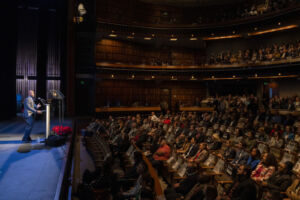The Tucson economy will regain momentum next year after a somewhat sluggish performance this year. That was one of the key takeaways from the University of Arizona Eller College of Management annual Economic Outlook Luncheon at the Westin La Paloma Resort in Tucson. More than 500 people packed the room on Dec. 8 to hear presenters George W. Hammond, director and research professor at Eller’s Economic and Business Research Center, and Anthony Chan, Chase chief economist, share their predictions regarding job growth, the housing sector, the stock market, interest rates and more.
Hammond shared that while the buzz about the Tucson economy has been strong this year, the official data has not reflected the same optimism.
“According to preliminary estimates, employment in the Tucson MSA, Pima County, was flat from the third quarter of 2016 to the same quarter this year. That was much slower than the national rate of 1.4 percent and slower than Tucson’s over-the-year growth rate in the third quarter of 2016, of 1.6 percent,” Hammond said. “However, more reliable job estimates have begun to trickle out and they show stronger gains through the first three months of the year.”
In particular, the preliminary data show a large drop in professional and business services employment during the past four quarters. The decline in this formerly-fast-growing sector was puzzling and it now looks like this drop will be revised away.
“All this likely means that we’ll see a large upward revision to Tucson’s job growth in 2017, which should help reconcile differences between the job data and the buzz around town,” he said.
Hammond then addressed housing permit activity, which accelerated in Tucson this year. According to preliminary Census data, total permits in Tucson were up 13.6 percent through the first nine months of the year, compared to the same period in 2016.
“Those gains were driven both by single-family activity, up 6.3 percent, and multi-family activity, which quadrupled from a suspiciously low number in 2016,” he said.
Data from the Federal Housing Finance Agency revealed that single-family home prices in Tucson rose 7.6 percent over the year in the third quarter of 2017. That was above the national rate of 6.4 percent, but below the rate of increase statewide of 8.5 percent and in Phoenix of 9.1 percent.
Addressing a decline in export growth, Hammond shared that so far in 2017, Arizona’s merchandise exports to the world have fallen by 10 percent from their peak in 2015, comparing the data through the first nine months of the year.
“Arizona’s merchandise exports to Mexico, our largest export destination, have fallen by 19.4 percent, driving the bulk of the decline. Exports to Canada, our second largest destination, are down 11.9 percent,” he said.
Meanwhile, the U.S. dollar remains elevated against most major currencies, with the trade-weighted value up 16 percent since mid-2014. The dollar remains strong against the Mexican peso as well, up 44.9 percent since mid-2014.



